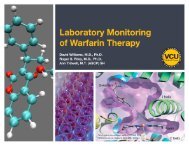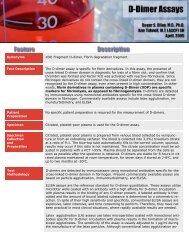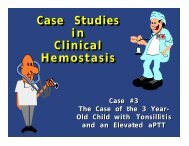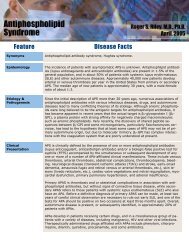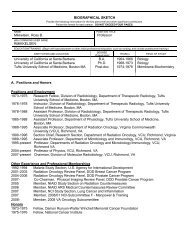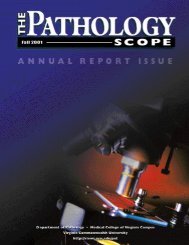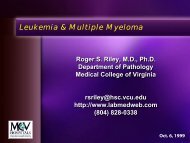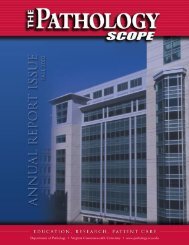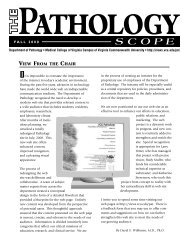What You Should Know About Abnormal Blood Clotting - Pathology
What You Should Know About Abnormal Blood Clotting - Pathology
What You Should Know About Abnormal Blood Clotting - Pathology
You also want an ePaper? Increase the reach of your titles
YUMPU automatically turns print PDFs into web optimized ePapers that Google loves.
Deadly <strong>Pathology</strong>/Killer <strong>Blood</strong> Clots<br />
Roger S. Riley, M.D., Ph.D.<br />
4<br />
Risk Factors for Thromboembolic Disease<br />
The major types of venous thromboembolism, deep venous thrombosis (DVT) and pulmonary embolism, are a<br />
leading cause of morbidity and mortality in hospitalized patients, but are being seen with increasing frequency in<br />
outpatients as well. The discovery of a number of acquired and inherited risk factors for thromboembolic disease<br />
has provided a means to predict the risk of these diseases and institute preventive therapy.<br />
Acquired Risk Factors<br />
Acquired risk factors for venous thromboembolism include surgery, smoking, trauma, fractures, immobilization or<br />
venous stasis, inflammatory diseases, pregnancy, the use of oral contraceptives containing synthetic estrogens,<br />
malignancy, congestive heart failure, and other diseases. Venous stasis in the extremities, venous obstruction,<br />
increased blood viscosity, and direct venous damage may cause or contribute to the development of venous<br />
thromboembolism. The increasing trend to early hospital discharge of postsurgical patients may be responsible for<br />
the increasing incidence of venous thromboembolism in outpatients. Venous thromboembolism usually involves<br />
the deep or superficial veins of the legs. <strong>Blood</strong> clots in the superficial veins (superficial thrombophlebitis) leads to<br />
localized tenderness, surrounded by an area of redness (erythema), heat, and edema. A thrombus can often be<br />
palpated in the affected vein. Although usually benign and self-limiting, superficial thromboemboli can cause<br />
serious complications if they extend into the other veins. Deep thrombi confined to calf veins rarely cause clinical<br />
problems, but can lead to pulmonary emboli.<br />
The antiphospholipid syndrome (APS) is another common acquired cause of thrombosis. APS is caused by<br />
autoantibodies that form against certain components of the coagulation system. In addition to venous and arterial<br />
thrombosis, including strokes, APS is associated with cause bleeding, miscarriages, and other medical problems.<br />
The long-term use of certain drugs, including chlorpromazine and phenothiazine, may result in APS. Generally,<br />
patients with APS have a 6-10x risk of developing venous thrombosis than normal individuals, and the risk of<br />
artial thrombosis is increased as well.<br />
Inherited Risk Factors<br />
The majority of patients who develop recurrent venous thromboemboli (thrombophilia) have discernable<br />
abnormalities of the coagulation system, including Factor V Leiden, deficiencies of protein C, protein S,<br />
antithrombin III, the prothrombin G20210A gene mutation, homocystinuria, or abnormalities of the fibrinolytic<br />
system. Most of these abnormalities cause deficiencies of the regulatory substances of clotting. Genetic<br />
abnormalities are especially common in individuals who develop thrombi at an early age (< 40 years) and in those<br />
with a family history of thrombosis. Although no genetic abnormality is detectable in about 15-20% of individuals<br />
with recurrent thromboembolic disease, research in this area is rapidly proceeding, and new genetic abnormalities<br />
may be described in the near future.<br />
Table II<br />
Common Inherited Thrombotic Diseases<br />
<strong>Abnormal</strong>ity<br />
Prevalence in Relative Risk of Venous Thrombosis*<br />
Thrombotic Disease<br />
Factor V Leiden 25-40% Heterozygous – 5 to 10; heterozygous + OCP –<br />
30 to 35; homozygous – 50 - 100, homozygous<br />
+ OCP - >>100<br />
Homocysteine abnormalities 10-25% Coronary artery disease – 2, stroke - 2.5,<br />
venous thrombosis – 7; hyperhomocysteinemia<br />
+ heterozygous Factor V Leiden - 20<br />
Prothrombin gene mutation 6-20% Heterozygous – 3; heterozygous + OCP – 16;<br />
homozygous - ??<br />
ATIII deficiency 3-5% Heterozygous – 5; homozygous – severe<br />
thrombosis at birth<br />
Protein C deficiency 5-6% Heterozygous – 7; homozygous – severe<br />
thrombosis at birth<br />
Protein S deficiency 5-6% Heterozygous – 6; homozygous – lethal prior to<br />
birth<br />
* The relative risk of venous thrombosis in a normal individual (without inherited thromboembolic genes) is 1.0.<br />
Oral contraceptives (birth control pills) increase the relative risk to 4 in a normal individual.



